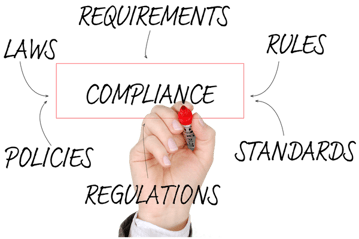

Blogs 
April 14, 2023
Living Security Team
6 Best Practices for Third Party Risk Management | Living Security

What is third-party risk management?
Blog Introduction: With businesses becoming increasingly reliant on third-party vendors, it’s essential for companies to understand the risks associated with working with these outsourced entities. That’s where third party risk management comes in. This practice focuses on assessing and mitigating the potential risks posed by any type of third party—from vendors to suppliers to contractors—to ensure that your organization can trust its partners and protect its data from malicious actors. Let’s take a closer look at this important concept.

What is the Primary Function of Third Party Risk Management?
The primary function of third party risk management is to assess and mitigate the potential risks posed by any third-parties your organization works with. These risks can come in many forms, including financial, operational, legal, and compliance-related matters. By carrying out regular risk assessments, organizations can ensure they are aware of any issues that may arise due to their partnerships with outside vendors or other external entities.
What Are the Types of Third Parties?
There are three main types of third parties that organizations must consider when assessing their risk management strategies: vendors, suppliers, and contractors. Vendors provide goods or services related to an organization’s operations; suppliers supply raw materials used in production; and contractors are hired to perform specialized tasks such as maintenance or repairs. All three types of entities pose unique risks that must be managed appropriately to ensure data security and compliance with industry regulations.
Why Is Third Party Risk Management Important?
Third party risk management is critical for protecting an organization’s data from malicious actors and ensuring compliance with industry regulations. By carrying out regular risk assessments, organizations can identify potential vulnerabilities before they become a problem and take steps to reduce their exposure to threats from outside sources. In addition, effective risk management helps organizations save time and money by avoiding costly mistakes due to inadequate vetting processes or poor contract negotiation strategies.
How Do Companies Carry Out Third Party Risk Assessment?
Carrying out a successful third-party risk assessment requires three distinct steps: identifying relevant risk criteria; sending out a questionnaire; and analyzing the results. The first step involves understanding what types of risks could potentially arise as a result of working with outside parties—from financial losses to information breaches—and determining which factors need to be evaluated in order for an accurate assessment to be made. Once this has been done, a questionnaire should be sent out so that pertinent information about each candidate can be collected prior to any contracts being signed or services being provided. Finally, all collected data should be analyzed in order to determine which candidates pose the greatest amount of risk based on their responses and background checks performed beforehand.
Third party risk management is an important part of any organization’s operations because it helps identify potential vulnerabilities before they become real problems while simultaneously ensuring compliance with industry regulations regarding data security protocols and contractual obligations between businesses and external partners. By following the steps outlined above—identifying relevant criteria; sending out questionnaires; analyzing results—organizations can make sure they are making informed decisions when it comes time to hire new vendors, suppliers, or contractors based on reliable data rather than guesswork alone. Doing so will help guarantee maximum protection against cyber threats while also providing peace of mind when dealing with outside entities on behalf of your company's operations.
Best Practices for Third-Party Risk Assessments
As businesses continue to rely on third-party vendors and services, it is critical to ensure that proper risk assessment measures are taken to protect against potential threats. Third-party risk assessments involve a detailed analysis of the vendors and their associated networks, products, and services. This process helps to identify potential risks that may arise from the relationship between the vendor and their customer. In this blog post, we will discuss some best practices for conducting third-party risk assessments.
Get to Know Your Vendors
A comprehensive list of all third-party vendors should be kept and updated regularly. This list should include information such as contact details, access levels, clearance levels and more. This can help you have a clear understanding of who is accessing your data and what level of access they have.
Categorize the Risks
Risk assessment should take into account the type of data that is being handled by the vendor or service provider as well as any potential risks associated with it. It is important to assess each vendor individually in order to accurately determine which security measures need to be taken in order to mitigate those risks.
Consider Automating the Process
The process of conducting third-party risk assessments can be complex and time consuming if done manually. For this reason, it is highly recommended that organizations consider automating the process in order to reduce human error and increase efficiency. Automated tools can also help streamline the process by providing accurate insights into potential risks quickly and without manual intervention.
Establish Compliance Requirements
Developing clear compliance requirements for third parties is essential for protecting your business’s data from unauthorized access or misuse. Having clearly stated compliance requirements can help promote security awareness amongst third party vendors, helping them understand how they are expected to handle sensitive customer data in order to stay compliant with relevant regulations and standards. Clear service level agreements (SLAs) should also be established in order to ensure that all vendors adhere to these requirements throughout their engagement with your organization.
Remember To Be Consistent
Risk assessments need to be conducted on an ongoing basis in order to ensure that any changes made by vendors do not create new security risks or vulnerabilities within your business’s infrastructure. Any changes made by a vendor should be carefully monitored so that they don’t introduce new vulnerabilities into your system or create a situation where customers’ data could be compromised due malicious activity or negligence on behalf of a vendor.
Develop a Reliable Process
The key ingredient for successful risk assessments lies in having a mature, reliable process from start till finish—from questionnaires through onboarding processes all the way up until audits are conducted at regular intervals during engagements with third parties. A mature approach allows organizations not only assess current systems but also anticipate future needs for risk mitigation strategies when engaging with new vendors or existing ones down the line.
In summary, taking proactive steps towards mitigating third party risks requires careful planning and execution. By following best practices such as getting familiar with your vendors, categorizing risks, automating processes, establishing compliance requirements, being consistent, and developing reliable processes organizations can ensure they are adequately protected against any threats posed by outside providers. With these steps taken organizations can rest assured knowing their data is safe while working with third parties.